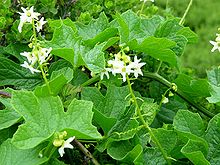- Marah oreganus
-
Marah oreganus 
Scientific classification Kingdom: Plantae (unranked): Angiosperms (unranked): Eudicots (unranked): Rosids Order: Cucurbitales Family: Cucurbitaceae Genus: Marah Species: M. oreganus Binomial name Marah oreganus
(Torr. ex S.Wats.) HowellMarah oregonus, the Oregon Manroot, Coastal Manroot or Western Wild-cucumber,[1] is a common manroot of the northern west coast of the United States. It ranges from California north to Canada.
Contents
Foliage
Coastal manroot has the least pubescent bud, leaves, and branches of all the manroot species. Northern populations are nearly hairless with glossy leaves. Vines appear in late winter or early spring in response to increased rainfall, and can climb or scramble to a length of 6m. Its leaves typically have five lobes with individual plants showing wide variation in leaf size and lobe length. Although leaf size is highly variable, Coastal manroot tends to have larger leaves than other marah species.
Vines emerge from a large, hard tuberous root which can reach several meters in length and weigh in excess of 100kg. Newly exposed tubers can be seen along roadcuts or eroded slopes and have a scaly, tan-colored surface. Injured or decaying tubers take on a golden or orange color.
Flower
The flower can vary in color from yellowish green to cream to white. Flowers appear soon after the vine emerges. The flowers are monoecious, that is, individual flowers are either male or female, but both sexes can be found on the same plant. Male flowers appear in open spikes while females flowers, distinguished by a swollen base, usually appear individually. The plant is self-fertile, i.e. pollen from the male flowers can fertilize the female flowers on the same plant; pollination is by insects.
Fruit
The fruit is spherical, 4-5 cm in diameter, and covered in prickles of variable density, up to 1cm long but without hooks. Unripe fruit are bright green, ripening to yellow. The fruit swells as it ripens until finally rupturing and releasing the large seeds. Fruit begin to form in spring and ripen in summer.
Seeds and germination
Seeds of the coastal manroot are large, hard, and smooth. Unlike the bullet-shaped seeds of other marah species, coastal manroot seeds are more flattened and disc-like. Fruit usually hold 4 or more seeds. Seeds have an intriguing germination process. The initial shoot emerges from the seed and grows downward into the earth. This shoot then splits, one part beginning to swell and form the tuber, while the second part grows back to the surface and becomes the vine.
Habits
Coastal Manroot grows most vigorously by streams or in washes but can also be successful in dryer areas, at elevations up to 1600 metres. It will tolerate a variety of soil types and acidities, but it requires at least seasonally moist soil. Vines can grow in full-sun to heavily shaded conditions. In mild areas of its range where year-round moisture is available, vines are perennial. In cold winter areas, vines die back in fall. In areas with seasonal wetness, vines emerge at the beginning of the wet season and die back completely in the dry season.
General
All parts of the plant have a bitter taste (this is the meaning of the genus name Marah, which comes from Hebrew). Despite this, the leaves have been used as a vegetable. The large tuber of the manroot can be processed for a soap-like extract.
Medicinal uses
Marah oreganus was used by the Native Americans for various health problems. The Chinook made a poultice from the gourd. The Squaxin mashed the upper stalk in water to dip aching hands. The Chehalis burned the root and mixed the resulting powder with bear grease to apply to scrofula sores. The Coast Salish made a decoction to treat venereal disease, kidney trouble and scrofula sores.
Gallery
References
- ^ "Marah oreganus". CalPhotos. University of California, Berkeley. http://calphotos.berkeley.edu/cgi/img_query?where-genre=Plant&where-taxon=Marah%20oreganus. Retrieved July 31, 2011.
External links
Categories:- Cucurbitaceae
- Flora of California
- Flora of Oregon
- Flora of the West Coast of the United States
- Traditional Native American medical plants
Wikimedia Foundation. 2010.




